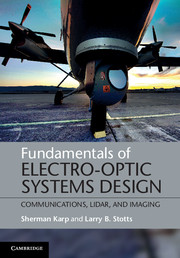Book contents
- Frontmatter
- Contents
- Preface
- Notation
- 1 Genesis of electro-optic systems
- 2 Role of electromagnetic theory in electro-optics systems
- 3 Photo-detection of electromagnetic radiation
- 4 Metrics for evaluating photo-detected radiation
- 5 Contrast, visibility and imaging
- 6 Signal modulation schemes in optical communications
- 7 Forward error correction coding
- 8 Modern communications designs for FOC/FSOC applications
- 9 Light detection and ranging
- 10 Communications in the turbulence channel
- 11 Communications in the optical scatter channel
- Appendix A Two-dimensional Poisson processes
- Appendix B Propagation of finite beams in water
- Appendix C Non-Lambertian scattering
- Appendix D Communications noise sources besides signal/background shot noise
- Index
- References
11 - Communications in the optical scatter channel
Published online by Cambridge University Press: 05 February 2013
- Frontmatter
- Contents
- Preface
- Notation
- 1 Genesis of electro-optic systems
- 2 Role of electromagnetic theory in electro-optics systems
- 3 Photo-detection of electromagnetic radiation
- 4 Metrics for evaluating photo-detected radiation
- 5 Contrast, visibility and imaging
- 6 Signal modulation schemes in optical communications
- 7 Forward error correction coding
- 8 Modern communications designs for FOC/FSOC applications
- 9 Light detection and ranging
- 10 Communications in the turbulence channel
- 11 Communications in the optical scatter channel
- Appendix A Two-dimensional Poisson processes
- Appendix B Propagation of finite beams in water
- Appendix C Non-Lambertian scattering
- Appendix D Communications noise sources besides signal/background shot noise
- Index
- References
Summary
Introduction
In Chapter 10, we discussed the effects on high-data-rate FSOC systems from atmospheric turbulence, which are dominated by scintillation / channel fading and beam wander, how they are modeled and how they are mitigated to yield high communications link / network performance. From some of the figures there, one can see channel dynamics on a very fast scale. When clouds insert themselves in the link, we suggested that RF communications (a hybrid system) could provide a means for keeping the link connected at a reasonably high, but much lower, data rate. This works well in the atmosphere in those climates where clouds are infrequent or sparse. This strategy does not work in the optical scatter channel where particulate absorption and scattering significantly degrade the incoming signal to the point that the original diffraction-limited beam becomes lost in the system noise floor. Alternate strategies must be employed to facilitate high communications link / network availability because of the significant degradation of the original signal by the atmospheric and maritime optical scatter channels. The signal structures that result from each channel are quite different from each other, as well as significantly different from the turbulence channel. Kennedy was one of the first to recognize that these significant differences in structure from the former relative to the latter could not be easily mitigated; he suggested that optical system designers exploit their new structures in order to close the communications link as typical mitigation techniques were useless in the diffusive scattering regime that defines high link availability [1]. Chapters 5 and 9 showed that it could be used for target imaging. This chapter will discuss how this approach can be used for communications in the optical scattering channel, highlighting the models and techniques used by today’s researchers and engineers.
Optical scatter channel models
Chapter 5 introduced the optical scatter channel by describing Mie scattering and its effect on optical signals. This introduced the inherent properties of the optical channel. In this section, we will expand this discussion, focusing on the detailed effects on laser communications created by the atmospheric and maritime scatter channels, and their modeling. Each has its own unique characteristics.
- Type
- Chapter
- Information
- Fundamentals of Electro-Optic Systems DesignCommunications, Lidar, and Imaging, pp. 249 - 282Publisher: Cambridge University PressPrint publication year: 2012



